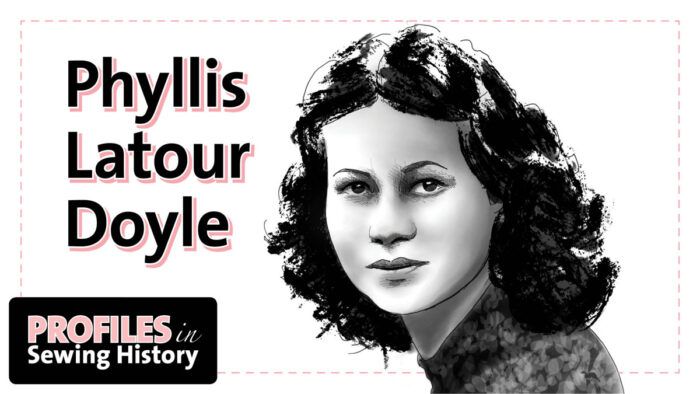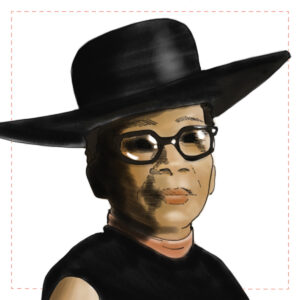Phyllis Latour Doyle | Profiles in Sewing History
The spy who used ingenuity and knitting tools to hide secret codes
This installment of the Profiles in Sewing History series focuses on a noteworthy individual with an unusual story. She isn’t known for her design ability or for making a new sewing invention. Instead, she was a British spy during World War II, who used knitting paraphernalia as a way to conceal secret codes. This woman took part in some extremely risky missions, but, thanks to her ingenuity, she was able to make it out alive. This is the story of Phyllis Latour Doyle.
Early life
Phyllis Latour was born in South Africa on April 8, 1921. Her father was a French doctor and her mother was a British citizen. Unfortunately, Phyllis’ father died within months of her birth, as a result of tribal wars in Africa. Three years later, Phyllis’ mother remarried. Her new husband was a race car driver, and she was occasionally allowed to drive the race cars for fun. One day, however, while Phyllis’ mom was out for a ride, she crashed the car. The accident took her life. Phyllis, an only child, went to live with her father’s cousin and his family nearby. Then, in 1939, Phyllis moved to Europe to complete her education.
Choosing a top secret career

In 1941, at age 20, Phyllis became a flight mechanic in the Women’s Auxiliary Air Force in England. By 1943, recruiters from the British Special Operations Executive (SOE) saw Phyllis’ potential and asked her to join their organization. The Air Force gave Phyllis three days to think it over, but she accepted the role on the spot. As it turns out, her godmother’s father (whom she regarded as her own grandfather) was shot by the Nazis and her godmother committed suicide after being taken prisoner by them. Phyllis wanted to avenge their deaths, and this was the perfect way to achieve that.
Joining the SOE was no cakewalk, though. Phyllis had to undergo intense physical training, which included practicing unarmed combat and learning how to scale buildings. She was taught how to use a Sten gun (a 9-mm submachine gun that was the standard weapon in the British Commonwealth during World War II) and how to repair broken wireless sets. She also was required to memorize Morse code. Luckily, all of this prepared Phyllis for her most difficult mission yet.
Phyllis Latour’s risky missions
On May 1, 1944, when Phyllis was just 23 years old, she parachuted into German-occupied Normandy and pretended to be a poor teenage French girl selling soap to German soldiers. This enabled her to track the soldiers’ positions for the Allies. She then used radio sets hidden throughout the country to send coded messages to London. This is where the knitting tools came into play and worked as a cover.
Phyllis explained in an interview with Judith Martin of New Zealand’s Army News magazine in 2009, “I always carried knitting because my codes were on a piece of silk—I had about 2,000 I could use. When I used a code I would just pin-prick it to indicate it had gone. I wrapped the piece of silk around a knitting needle and put it in a flat shoelace, which I used to tie my hair up.”
The truth is, Phyllis was stopped and searched by authorities on several occasions.
The NZ Army News magazine also reported her recollection about when she was among several local people rounded up by the police: “I can remember being taken to the station and a female soldier made us take our clothes off to see if we were hiding anything. She was looking suspiciously at my hair, so I just pulled my lace off and shook my head. That seemed to satisfy her. I tied my hair back up with the lace—it was a nerve-wracking moment.”
Despite this and other close calls, no one was ever able to detect where Phyllis kept her secret codes.
Her knitting and the knitting needle trick truly saved her life. Because of it, she ended up sending a total of 135 coded messages to the British military and was instrumental in guiding bombing missions to enemy targets prior to D-Day.
The aftermath

After the war, Phyllis’ life calmed down for the most part. She married Patrick Doyle, an Australian engineer. Together, they had four children and moved to Kenya, Fiji, and, eventually, to Australia. (The couple was divorced in the 1970s.) As it turns out, Phyllis’ children didn’t even know about their mother’s past until her eldest son read about Phyllis on the internet around the turn of the century. Her children were adamant that she get her medals, and she eventually agreed to do so.
In 2014, in commemoration of the 70th anniversary of D-Day, Phyllis was awarded France’s highest military honor, the Chevalier of the Legion of Honour, by the French ambassador to New Zealand, Laurent Contini. It was a momentous occasion that her children were able to share with her. While Phyllis remained humble, she did say that receiving the medal was a “privilege and honor.”
Phyllis is a true hero who was willing to put the lives of others before her own. In fact, the men who were sent out just before her May 1 mission were caught and murdered. Phyllis certainly made the most of her time as a spy and defied the odds. She was a smart, creative thinker who used everyday knitting in her spy craft. Today, Phyllis is 100 years old and resides in Auckland, New Zealand.
What do you think about Phyllis’ story? Were you aware that knitting played such an important role in World War II? Please share your thoughts below.
Click here for additional installments of Profiles in Sewing History.
Sources
Field, Michael. “Pippa’s Astonishing Story Recognised.” Stuff, 25 Nov. 2014, www.stuff.co.nz/national/63516307/pippas-astonishing-story-recognised.
Martin, Judith. “Pippa’s War.” New Zealand Army News, 2009, www.nzdf.mil.nz/army/magazine/.
A Mighty Girl Staff. “Phyllis Latour Doyle: The Forgotten Spy Whose Knitting Helped Pave the Way for D-Day.” Amightygirl, 7 Apr. 2020, www.amightygirl.com/blog?p=25020.
MisionPeggyCarter. “PHYLLIS LATOUR DOYLE.” Wattpad, www.wattpad.com/421584081-women-in-war-the-real-life-agent-carters-15.
“Phyllis Latour Doyle: S.O.E Agent & Radio Operator in World War Two.” The History Researcher, 23 Sept. 2017, chrissyhamlin.blogspot.com/2017/09/the-second-world-war-produced-many.html.
Srinath, Shreya. “Secrets in Silk.” Medium, 9 June 2018, medium.com/@srinath.shreya/secrets-in-silk-e90b2a763f09.
Stone, Andrew. “A Spy Called Genevieve.” NZ Herald, 14 Nov. 2014, www.nzherald.co.nz/nz/a-spy-called-genevieve/7O4QIALVKFNO7TWW4DMHZB6BY4/.
Illustration: Steven Fleck.
































Wow, I’m always amazed by ingenuity and courage! I would like to have seen the way the silk was marked.
And some people think needlework is boring. More seriously, whatever drove her actions she must have been fierce. Indeed, just by seeing the photo of her today she likely still is.